BSP-XY and BOP-XY are the next simplest strategies after BSP and BOP in our ebook Simple Trading Strategies That Work. Below is a table of the top 12 ETFs out of the 145 we tested, that did a good job predicting SPY using BSP-XY and BOP-XY over the last 10 months plus about 2 weeks (218 trading days from May 1, 2011 to Mar 12, 2012).
As our ebook discusses, the BSP-XY/BOP-XY strategies are closely linked to correlation, so we started by creating a list of those ETFs that had a correlation coefficient magnitude of more than 0.5 with SPY. There were 96 out of 145. Then for each of those 96 ETFs, we tested how well the strategy worked on SPY. The top 12 are shown below.
| Ticker | BOP-XY | \(\rho\) | |||
|---|---|---|---|---|---|
| 1 | THD | 50.87 | 0.6597 | ||
| 2 | EWM | 48.95 | 0.6950 | ||
| 3 | TUR | 47.37 | 0.5635 | ||
| 4 | GSG | 46.49 | 0.8022 | ||
| 5 | DVY | 37.91 | 0.9249 | ||
| 6 | EWG | 34.07 | 0.6995 | ||
| 7 | EZU | 33.25 | 0.5956 | ||
| 8 | MOO | 32.65 | 0.8020 | ||
| 9 | DBV | -31.67 | 0.8610 | ||
| 10 | EWS | 30.13 | 0.5705 | ||
| 11 | IEV | 29.91 | 0.6911 | ||
| 12 | EWY | 29.75 | 0.7729 |
The BOP-XY column is in units of profits per share in U.S. dollars. The trading period is from close to close, with no transaction cost. The BSP-XY strategy is the opposite of BOP-XY, therefore a negative value in the BOP-XY column indicates that BSP-XY should be used to get a positive return. DBV at number 9 is the only one of these. The \(\rho\) column is the correlation coefficient with SPY over the 218 trading days.
Below are plots of BOP-XY profit per share (red) along with the closing price (blue) for the top 5 ETFs.
The top performer was THD (iShares MSCI Thailand Index Fund). Using it to predict SPY with the BOP-XY strategy would have made 52.84 per share, whereas the dumb buy and hold strategy on SPY would have earned you a modest 1.85 per share. That's a factor of 28.56, or 2756% better than buy and hold. The returns on this have declined since the beginning of the year.
Close behind at number 2 is EWM (iShares MSCI Malaysia Index Fund) with a return of 48.95 per share. This one has been oscillating since the end of 2011. TUR (iShares MSCI Turkey Investable) is number 3 with a return of 47.37. This has been flat since the beginning of the year. The Goldman Sachs Commodity Index ETF GSG is at number 4 with a return of 46.49. This has seen a positive return since the start of the year, but has been flat since the start of February. DVY is at number 5 with 37.91. This stands out from the top 5 in that it's been climbing nicely since the start of the year.
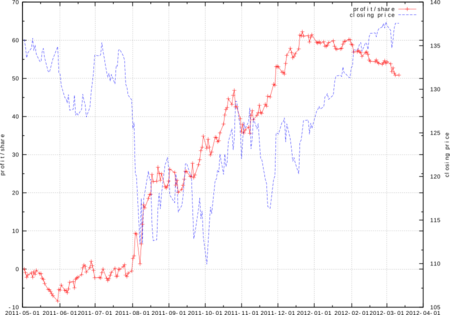
BOP-XY strategy using THD to predict SPY since May 1, 2011. Click for larger image.
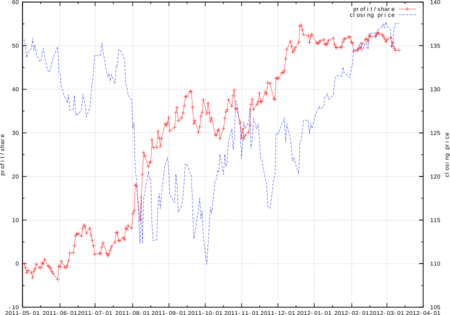
BOP-XY strategy using EWM to predict SPY since May 1, 2011. Click for larger image.
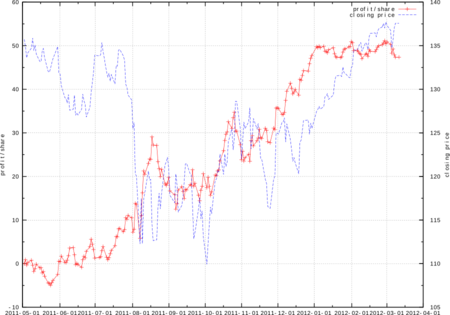
BOP-XY strategy using TUR to predict SPY since May 1, 2011. Click for larger image.
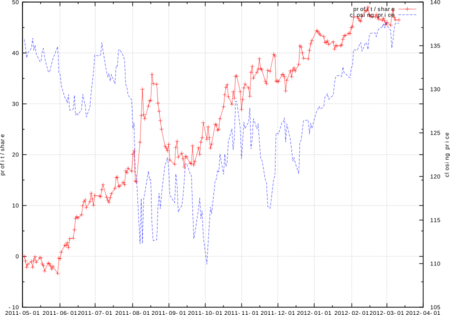
BOP-XY strategy using GSG to predict SPY since May 1, 2011. Click for larger image.
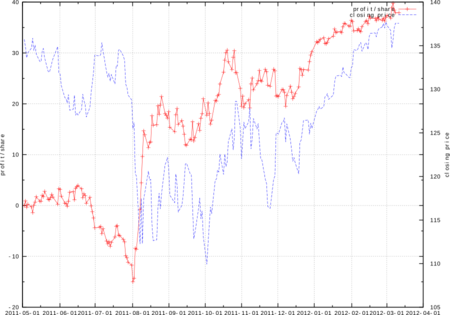
BOP-XY strategy using DVY to predict SPY since May 1, 2011. Click for larger image.
Can you explain these results? In the case of THD predicting SPY it seems that when U.S. equities are not doing well, then money flows into emerging market equities such as Thailand, and vice versa. You can probably come up with a good explanation for some of the other results and in the process learn something about how money flows in the markets.
For more details on the BOP-XY and BSP-XY strategies, and for other strategies see our ebook Simple Trading Strategies That Work.
© 2010-2012 Stefan Hollos and Richard Hollos
blog comments powered by Disqus